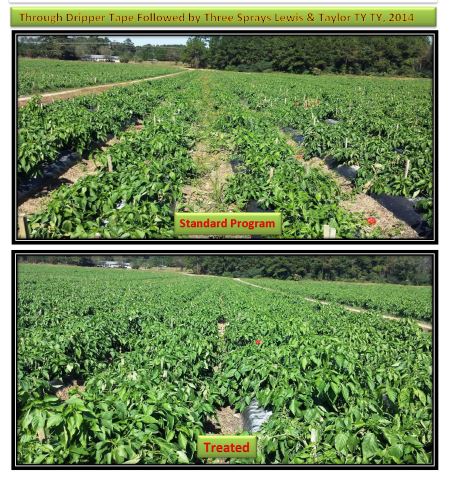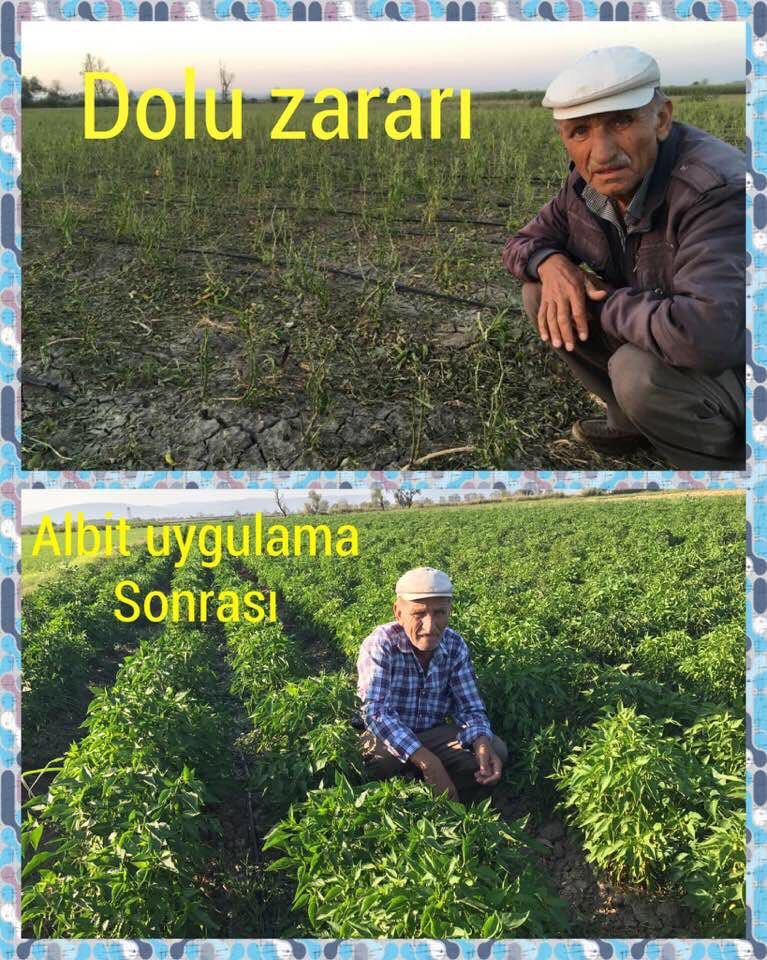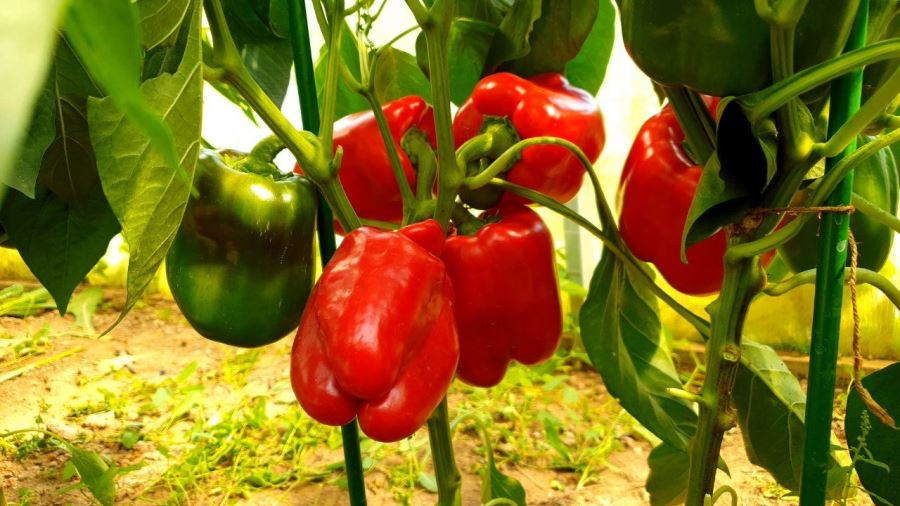 |
An innovative plant growth promoter for organic and traditional farming
|
Peppers |
|
Materials of this chapter were published in the article by M.S. Gins, O.N. Lush, L.V. Suslova, A.K. Zlotnikov: The effect of biostimulants on the productivity of capsicum (2005), Potatoes and Vegetables, 3 (24).
 Sweet pepper, or sweet pepper, is one of the many varieties of annual vegetable capsicum (Capsicum annuum, Solanaceae family). Peppers are high in vitamins: C, B1, B2, B6, B9, P, PP. Sweet pepper surpasses lemons and black currant in the amount of vitamin C: one medium pepper contains over 150% of the daily vitamin Ñ requirement. Different sweet pepper varieties are rich in antioxidant vitamins A and E; red and green fruits also contain vitamin K. These vegetables are rich in antioxidants such as violaxanthin, lutein, quercetin, luteolin. Peppers have high mineral content: potassium, calcium, magnesium, sodium, phosphorus, fluorine, iron, chlorine, zinc, manganese, copper, iodine, chromium, sulfur, cobalt.
Sweet pepper, or sweet pepper, is one of the many varieties of annual vegetable capsicum (Capsicum annuum, Solanaceae family). Peppers are high in vitamins: C, B1, B2, B6, B9, P, PP. Sweet pepper surpasses lemons and black currant in the amount of vitamin C: one medium pepper contains over 150% of the daily vitamin Ñ requirement. Different sweet pepper varieties are rich in antioxidant vitamins A and E; red and green fruits also contain vitamin K. These vegetables are rich in antioxidants such as violaxanthin, lutein, quercetin, luteolin. Peppers have high mineral content: potassium, calcium, magnesium, sodium, phosphorus, fluorine, iron, chlorine, zinc, manganese, copper, iodine, chromium, sulfur, cobalt.
Albit is used on sweet pepper as an antidote (safener) to reduce the phytotoxic effect of pesticides. Albit increases the germination rate, activates plant growth and development, increases resistance to adverse environmental conditions, reduces disease damage, increases early yield and overall yield, increases the vitamin content in fruits, decreases the nitrate content, and improves product quality.
Application method. We recommend conducting a pre-sowing seed treatment and two treatments during the growing season to achieve the maximal beneficial effect. Before sowing, pepper seeds are soaked in the working solution of Albit with a concentration of 2 ml/L of water for three hours. The application rate of Albit is 2 ml/kg of seeds; the working solution rate is 1 L/kg of seeds. We recommend spraying during vegetation in the 2-3 true leaves’ phase (BBCH 12-13) and 15 days later. The application rate of Albit is 30 ml/ha; the working solution rate is 300 L/ha. After planting the seedlings, we recommend watering the soil with a 1-2 ml/L water solution (this concentrated solution is applied to soil near the roots, not on plants' leaves). Two sprays are the minimal requirement for treatments. Sometimes intensive use of chemicals is the case, especially in glasshouse conditions. If this is the case, we recommend using Albit as an antidote (safener) every 1-2 weeks alongside the routine pesticide treatments (up to 10 per growing season) at a working solution rate of 1-2 ml/10 L (or 30-65 ml/ha). Albit can also be applied through drip irrigation: 2 ml/10 L of product is added to the irrigation system and supplied until the final rate of 1 L of Albit per ha is reached (three times in the first half of the growing season). Similarly, a solution of 1-2 ml/10 L can be used for regular irrigation instead of water (the solution should wet the plants' leaves).
Albit has been used on sweet pepper var. Lastochka and others in Russia (Federal Scientific Center for Vegetable Growing and other institutes and farms), as well as in Turkey, the USA, China, and other countries.
In 2001 and 2003, Albit was tested on sweet pepper in field trials of the Federal Scientific Center for Vegetable Growing on var. Lastochka. Results showed a 1.6-5.6 t/ha yield increase in the Albit treatment group (+6-26.5% to control). Albit was noted to increase the germination rate and plant height by 10-15%. Albit increased the turgor pressure in plants, accelerated the ripening process with harmonious ripening. The effect of Albit was similar to the effect of standard fertilizers with epibrassinolide and Pseudomonas aureofaciens in terms of economic and biological efficiency.
The positive effect of Albit on the growth and development of capsicum plants shows at the early development stages. In 2008, in the Demre greenhouse complex in Turkey, peppers in the Albit treatment group increased in size by 15-20 cm (Fig. 1).

Fig. 1. The effect of Albit on the growth and development of peppers in the Demre greenhouse complex. Crops treated with Albit (left), crops without Albit (right) (Antalya, Turkey, 2008)
In 2014, Lewis & Taylor farm in Georgia, USA, included Albit in the drip irrigation system for peppers that were grown outdoors. Albit treatments facilitated a significant acceleration of plant growth and development (Fig. 2).
 |
 |
Fig. 2. Albit accelerates the growth and development of sweet pepper crops. ‘Standard program’ - control, ‘Treated’ – Albit treatment (Lewis & Taylor farm, Georgia, USA, 2014)
Apart from growth and development acceleration and yield increase, Albit also demonstrates a stress-relief or anti-stress activity on sweet pepper. Trials on various crops showed that Albit facilitates an increased resistance to environmental stress factors, such as pesticide stress, extreme high or low temperatures, drought, various mechanical damage. The same can be said about the plants affected by hail: after Albit treatment, crops undergo a swift recovery, regenerate, and begin to develop new leaves and shoots. In 2017, a severe hailstorm damaged the freshly planted peppers in Turkey. After urgent spraying with Albit, damaged plants began to recover, strengthened, and demonstrated an accelerated growth and development (Fig. 3).

Fig. 3. Damaged sweet pepper crops before Albit treatment (above) and recovered crops after Albit treatment (below) (Turkey, 2017)
Kirill Makarovich Zlotnikov, the creator of the Albit, grows peppers in his private back garden. Below is a photograph of capsicum grown with Albit (Fig. 4).

Fig. 4. Peppers grown with Albit (Pushchino, Moscow Oblast, 2020)
Trial reports of studies that examined the effectiveness of Albit on peppers. The trials in the table are sorted by year in descending order, and within each year, by region in alphabetical order
| NOTICE: | Information contained on this page is provided according
to the Terms and Conditions located at
www.albit.com/application/disclaimer.php
|